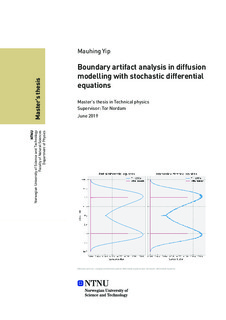| dc.description.abstract | In many research areas, it is common to model advection-diffusion problems
with Lagrangian particle methods. This is the same as solving a stochastic
differential equation, with drift and diffusion coefficients derived from the
advection-diffusion equation. But there is also a necessary condition for the
particle method to be equivalent to the Eulerian advection-diffusion equation,
is that it satisfies the well-mixed condition (Thomson, 1987), which says that
if particles are well mixed, they have to stay well mixed later on. This is just a
statement with respect to second law of thermodynamics, which is entropy. A
commonly used implementation of reflecting boundary conditions for particle
methods is analysed. We find that in some cases, this reflecting scheme will
give rise to oscillations in concentration close to the boundary, which we call
the boundary artifact.
We analyse the reflection scheme in the Lagrangian model, and compare
it to Neumann boundary conditions in the Eulerian model. We find that if
the diffusivity has a non-zero derivative at the boundary, this violates one of
the conditions for equivalence with the advection-diffusion equation, which
is that the drift coefficient in the SDE must be Lipschitz continuous. This
seems to be the origin of the boundary artifact. We analyse the artifact
further, and describe two different types of boundary artifact.
We suggest different approaches to dealing with the problem, and find
that the problem can in practice be handled by adjusting the diffusivity
close to the boundary. Support and motivation for such a change is found in
the concept of the ”unresolved basal layer” (Wilson & Flesch, 1993), which is
a pragmatic idea stating that closer than some distance from the boundary,
we simply cannot know the details of the turbulent motion. | |
